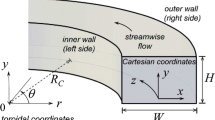Abstract
The induced-charge electrokinetic flow (ICEKF) in a rectangular micorchannel with a pair of conducting triangle hurdles embedded in the middle is investigated in this paper. A correction method is suggested to numerically estimate the induced zeta potential on the conducting surface. Two-dimensional pressure-linked Navier-–Stokes equation is used to model the flow field in the channel. The numerical results show flow circulations generated from the induced non-uniform zeta potential distribution along the conducting hurdle surfaces. It is demonstrated numerically that the local flow circulations provide effective means to enhance the flow mixing between different solutions; by adjusting the electric field applied through the microchannel with a non-symmetric triangle hurdle pair, an electrokinetic flow regulating effect can be obtained and this effect depends on the dimensions of the conducting converging–diverging section. The mixing and flow regulating using ICEKF described in this paper can be used in various microfluidics and lab-on-a-chip (LOC) applications.















Similar content being viewed by others
References
Biddiss E, Erickson D, Li D (2004) Heterogeneous Surface Charge Enhanced Micromixing for Electrokinetic Flows. Anal Chem 76:3208–3213
Chin CD, Linder V, Sia SK (2007) Lab-on-a-chip devices for global health: past studies and future opportunities. Lab Chip 7:41–57
DeMello AJ (2006) Control and detection of chemical reactions in microfluidic systems. Nature 2006 442:394–402
Dertinger SKW, Chiu DT, Jeon NL, Whitesides GM (2001) Generation of gradients having complex shapes using microfluidic networks. Anal Chem 73:1240–1246
Dittrich PS, Manz A (2006) Lab-on-a-chip: microfluidics in drug discovery. Nat Rev Drug Discov 5:210–218
El-Ali J, Sorger PK, Jensen KF (2006) Cells on chips. Nature 442:403–411
Harrison DJ, Manz A, Fan Z, Luedi H, Widmer HM (1992) Capillary electrophoresis and sample injection systems integrated on a planar glass chip. Anal Chem 64:1926–1932
Harrison DJ et al (1993) Micromachining a miniaturized capillary electrophoresis-based chemical analysis system on a chip. Science 261:895–897
Hunter RJ (1981) Zeta potential in colloid science: principals and applications. Academic, New York
Ismagilov RF, Rosmarin D, Kenis PJA, Chiu DT, Zhang W, Stone HA, Whitesides GM (2001) Pressure-driven laminar flow in tangential microchannels: an elastomeric microfluidic switch. Anal Chem 73:4682–4687
Jacobson SC, Hergenroder R, Koutny LB, Warmack RJ, Ramsey JM (1994) Effects of injection schemes and column geometry on the performance of microchip electrophoresis devices. Anal Chem 66:1107–1113
Jacobson SC, Ermakov SV, Ramsey JM (1999) Minimizing the number of voltage sources and fluid reservoirs for electrokinetic valving in microfluidic devices. Anal Chem 71:3273–3276
Jeon NL, Chiu DT, Wargo CJ, Wu H (2002) Microfluidics section: design and fabrication of integrated passive valves and pumps for flexible polymer 3-dimensional microfluidic systems. Biomed Microdevices 4:117–121
Johnson TJ, Ross D, Gaitan M, Locascio LE (2001) Laser modification of preformed polymer microchannels: application to reduce band broadening around turns subject to electrokinetic flow. Anal Chem 73:3656–3661
Keh HJ, Anderson JL (1985) Boundary effects on electrophoretic motion of COLLOIDAL spheres. J Fluid Mech 153:417–439
Laser DJ, Santiago JG (2004) A review of micropumps. J Micromech Microeng 14:R35-R64
Lee J, Hu Y, Li D (2005) Electrokinetic concentration gradient generation using a converging–diverging microchannel. Anal Chim Acta 543:99–108
Seiler K, Harrison DJ, Manz A (1993) Planar glass chips for capillary electrophoresis: repetitive sample injection, quantitation, and separation efficiency. Anal Chem 65:1481–1488
Squires TM, Bazant MZ (2004a) Induced-charge electro-osmosis. J Fluid Mech 509:217–252
Squires TM, Bazant MZ (2004b) Induced-charge electrokinetic phenomena: theory and microfluidic applications. Phys Rev Lett 92: 066101
Squires TM, Bazant MZ (2006) Breaking symmetries in induced-charge electro-osmosis and electrophoresis. J. Fluid Mech 560:65–101
Unger MA, Chou HP, Thorsen T, Scherer A, Quake SR (2000) Monolithic microfabricated valves and pumps by multilayer soft lithography. Science 288:113–116
Whitesides GM (2006) The origins and the future of microfluidics. Nature 442:368–373
Author information
Authors and Affiliations
Corresponding author
Rights and permissions
About this article
Cite this article
Wu, Z., Li, D. Mixing and flow regulating by induced-charge electrokinetic flow in a microchannel with a pair of conducting triangle hurdles. Microfluid Nanofluid 5, 65–76 (2008). https://doi.org/10.1007/s10404-007-0227-7
Received:
Accepted:
Published:
Issue Date:
DOI: https://doi.org/10.1007/s10404-007-0227-7




